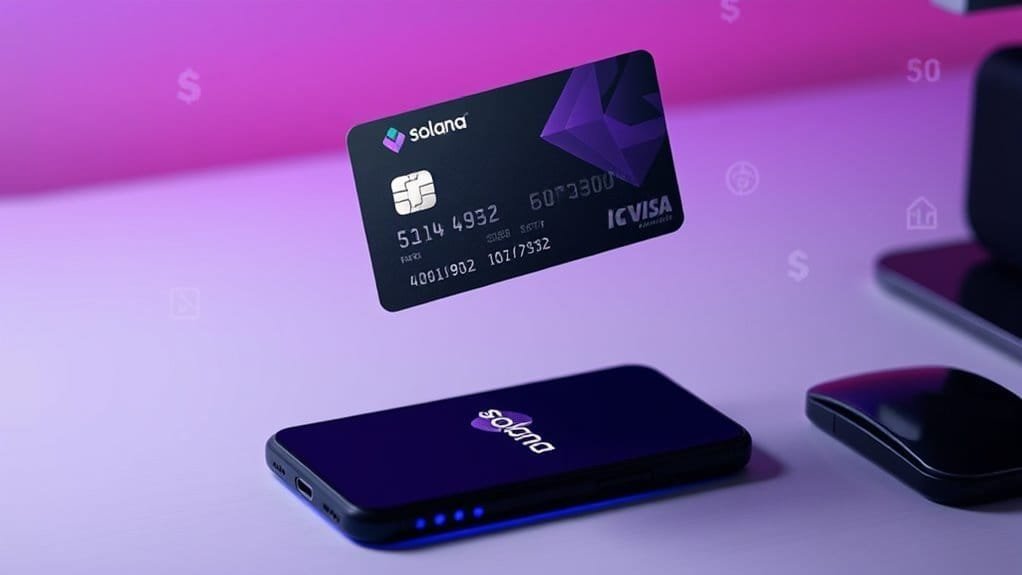Zebec just dropped a crypto debit card on Solana’s blockchain, backed by Mastercard. No fees, no ID checks for U.S. folks. Users can reload up to $1,000 per transaction with a daily limit of $10,000. It works with Apple Pay and Google Pay right out the gate. USDC converts to dollars at 1:1, keeping things simple. Solana’s speed means transactions finish before you can blink. The competition’s heating up.

Zebec has officially launched its crypto debit card on the Solana blockchain, making the leap from digital assets to everyday purchases. Called Zebec Carbon, the Mastercard-powered card strips away the usual frustrating fees that plague traditional banking. No sign-up costs. No monthly charges. Zero transaction fees. It’s about time someone made spending crypto this simple.
U.S. residents can activate the card instantly—no tedious ID verification required. The launch date of March 27, 2025 marks a significant milestone in bridging cryptocurrency with traditional payment systems. The sleek piece of plastic works everywhere Mastercard is accepted globally. That’s millions of locations where your digital assets can now buy coffee, groceries, or that impulse purchase you’ll probably regret tomorrow. Apple Pay and Google Pay compatibility means your phone becomes your wallet too.
Instant activation meets global spending power—your crypto, your coffee, your regrettable impulse buys, all without the verification headache.
The numbers are impressive. Users can reload up to $1,000 per transaction and spend up to $10,000 daily. Stablecoins like USDC convert to dollars at a 1:1 ratio when you make purchases. No math degree required to figure out what you’re spending. With the lower transaction fees associated with cryptocurrencies, users can maximize their spending power without worrying about high costs.
Solana’s blockchain underpins the whole operation, which explains the lightning-fast transaction speeds. While Ethereum users are still waiting for their coffee payment to clear, Solana users have finished their drink and left the café. The network’s scalable design means the system won’t crash when adoption increases—theoretically, anyway. This initiative builds upon Zebec’s core technology that enables continuous money streams for real-time transactions.
Zebec isn’t alone in this space. MetaMask, Floki, and Avalanche have all jumped into the crypto debit card pool, each with their own spin. Competition is heating up. Fast.
Regulatory obstacles remain the elephant in the room. Crypto rules vary wildly across countries, and staying compliant isn’t exactly a walk in the park. Security concerns loom large too—nobody wants their digital assets disappearing into some hacker’s wallet.
Looking ahead, Zebec plans to utilize its real-time money stream technology for broader applications. The Solana ecosystem provides fertile ground for innovation, and continuous funding rounds suggest investors believe in what’s coming next. For now, though, the focus is simple: making crypto actually useful in daily life.
Frequently Asked Questions
What Fees Are Associated With the Zebec Crypto Debit Card?
The Zebec card isn’t totally “zero-fee” despite the marketing.
While there are no sign-up, monthly, or transaction fees, users still pay for the physical card. Virtual cards cost 10 euros, physical ones 32 euros plus shipping.
There’s also a 2% fee when topping up the card.
But hey, at least transactions themselves don’t incur charges.
Stablecoin conversions happen at 1:1 rates.
Is the Card Available Internationally or Limited to Specific Regions?
The Zebec payment card is available in the UK and 26 European countries, with notable exclusions like Austria and the Netherlands. Not worldwide yet.
The US launch is coming “later this year”—whenever that means. A waitlist exists for Americans.
Meanwhile, their other product, Zebec Instant card, reaches 140 countries but skips Russia and Ukraine.
Payment network backing means it works globally wherever payment network is accepted.
How Does the Card Handle Crypto Market Volatility?
Crypto market volatility? Not a problem for this card. It converts stablecoins to fiat at a 1:1 ratio, bypassing those wild crypto price swings.
Smart users stick with stablecoins anyway to avoid getting burned. Solana’s been crazy volatile lately—60-day Realized Volatility over 100%!
The card’s zero fees help too. No extra costs when markets go nuts. Spending limits add another safety layer for those jumpy crypto days.
What Security Features Protect Users From Unauthorized Transactions?
The card packs serious security muscle. Advanced protocols block unauthorized access while maintaining transaction privacy.
No ID checks required—seems risky, right? Wrong. There’s still $1,000 per transaction and $10,000 daily limits.
On-chain tracking keeps everything transparent without exposing user data. Compatible with Apple Pay and Google Pay, it adds their security layers too.
Plus, stablecoin usage eliminates those wild crypto swings that could drain accounts.
Can All Solana-Based Cryptocurrencies Be Loaded Onto the Card?
Specific details about which Solana-based cryptocurrencies can be loaded onto Zebec’s card remain unclear.
The card supports multiple cryptocurrencies, with emphasis on stablecoin conversion at 1:1 rates. It’s likely not all Solana tokens are supported—regulations and technical limitations probably restrict some.
The ecosystem hosts diverse projects from Solend to Star Atlas, but Zebec hasn’t published an extensive list.
Pretty vague, honestly. Users should check directly with Zebec.

